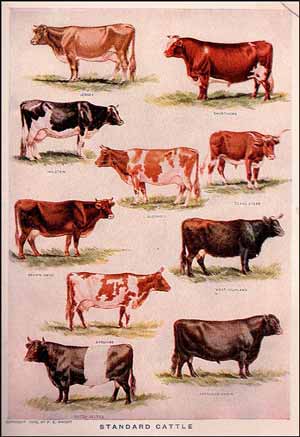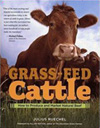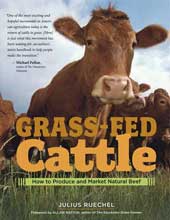The Seven Rules for Producing Great Beef: 1 2 3 4 5 6 7
Feeding cattle:
gauging the correct finishing weights on pasture

Image Credit: Sue Clark, Flickr, CC BY 2.0
In the previous article of this series (Rule # 1) about the Seven Unbreakable Rules for Producing Great Beef, I explained how, when feeding cattle for slaughter, beef tenderness and flavor depends on microscopic intramuscular fat deep within the muscle fibers of the beef animal.
I also explained that this vital microscopic intramuscular fat is only deposited once cattle reach maturity - it does not develop in younger cattle no matter how obese they get.
But beef cattle come in many different sizes, which means that the time it takes to fatten cattle for slaughter will vary dramatically depending on their size. This has some serious implications for how you structure your cattle finishing strategy.
This article I will explore how the breed and size of individual cattle affects their target "finished weight" when they are fat enough to go to slaughter.
(Rule # 2)
The ‘finished weight’ when an animal is fat enough for slaughter will vary from breed to breed and depends on the frame size of the individual animal.
Frame Size vs Finishing Weight
A smaller-boned animal stops growing earlier than a larger-boned animal. It will therefore be finished sooner, but at a lighter weight than a taller larger-framed animal. While this seems rather obvious, it is a key reason why many novice grass-fed producers feeding cattle for slaughter fail to produce consistently tender, flavorful beef.
A common mistake among many pasture-finishing programs is that they fail to account for size differences in their cattle finishing programs. They often want to slaughter all their calves by the end of the second growing season to avoid another winter of high feed costs. But larger-sized calves within the group will still be underfinished - they need more time. If they are slaughtered at the same time as the smaller-framed calves, their beef will be tough.
The expectations of a cattle finishing program must be suited to the size of the cattle being finished. A grass-fed producer simply cannot expect to slaughter a Simmental steer at 18 months of age and at 1060 lbs when the bulk of his Angus steers will be ready. He will need to hold his Simmental calves over another winter, slaughtering them when they reaches about 1400 lbs at around 24-26 months of age. Most tropical cattle breeds get even larger (1700 lbs or more), and take even longer (30+ months)!
Target finishing weight is individual. It is not the same for all cattle even from the same breed.
Either pick cattle genetics to match the expectations you have for your grass-finishing program or design your grass-finishing program to suit the cattle genetics that you already own.
Nor is it true that all cattle from a single breed will have the same target finishing weight.
Target finishing weight actually depends on the size (bone structure) of every single individual animal. And although cattle from within the same breed are sized relatively similarly, there are still sufficient size differences within any breed that you actually have to adjust the target finishing weight for every individual animal to account for individual size differences.
The article about hip height vs target slaughter weight provides the look-up tables for steers, heifers, mature cows and mature bulls so you can calculate the exact target slaughter weight of every single animal on your farm, simply by measuring their hip heights.
You can learn more about how to select the ideal breed to suit your climate, environmental conditions and marketing strategy in the "Genetics and Breeding" chapter of Grass-fed Cattle: How to Produce and Market Natural Beef.
Tips for Evaluating Cattle Slaughter-Readiness on Pasture
When feeding cattle in a feedlot, cattle are generally organized by age and weight. If there are enough animals they are also divided by size (i.e. all medium-framed animals grouped together).
Gauging slaughter-readiness then becomes a simple matter of periodically weighing the cattle to assess if the majority of the group has reached their ideal target weight based on the hip height vs slaughter weight lookup tables I discussed above
While this strategy works well in a feedlot setting, when feeding cattle for slaughter on pasture you do not need to
sort them into size-groups or constantly weigh them. With experience,
grass-fed cattle producers can become very adept at judging whether
their cattle are fat enough for slaughter. It is a combination of
knowing your breed’s characteristics (i.e. what does a typical finished Angus or Simmental look like), approximating their weight, and
judging how fat they look.
The first few times you evaluate cattle by eye this may seem rather daunting, but you can train your eye with experience. Whenever you have the cattle in the corral, take the time to measure their hip heights and weight them, then use the look-up tables to see how close they are to being finished. You will soon get quite adept at eyeballing when it’s time for the beeves to go to slaughter. Experienced cattlemen often learn to judge their cattle’s weights to within 25 to 40 pounds.
Owning a good weigh scale is vital if you are finishing cattle for slaughter. It is a good tool to help you calibrate your eye, but most important of all, it is essential to provide the final confirmation that your cattle have indeed reached their target weight prior to loading them onto the truck destined for market.
(Disclosure: I get commissions for purchases made using Amazon links in my post.)
You do not need to spend thousands of dollars to get a stand-alone cattle weigh scale. The cheapest solution is to simply mount a set of weigh bars#CommissionsEarned underneath your cattle squeeze.
Moving On...
This correlation between hip height and target slaughter weight is the most important step in producing consistently tender flavorful beef. But there are lots of little obstacles that can still undermine tenderness and flavor by temporarily draining the vital fat from the microscopic intramuscular fat cells discussed in Rule #1, even if the cattle have reached their target slaughter weight!
These obstacles are the subject of the remaining articles in this series about the Seven Rules of Producing Great Beef.
The next article in the series will explain why reaching the target weight is not enough. Cattle must also still be gaining weight at the time they are slaughtered if you want the beef to retain all its tenderness and flavor.
Continue to:
Related Articles:
(Disclosure: I get commissions for purchases made using Amazon links in my post.) And when you're ready to start planning your cattle farm, check out my book: Grass-Fed Cattle: How to Produce and Market Natural Beef. Use the links below to explore my book and read reviews on Amazon: 
|



